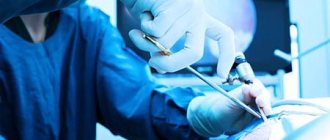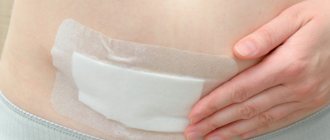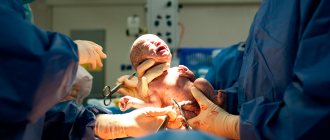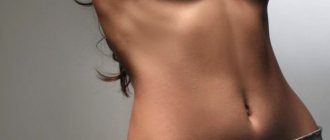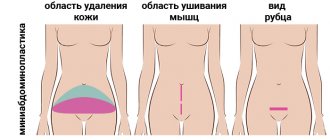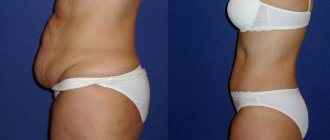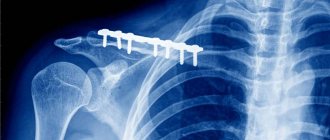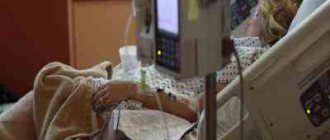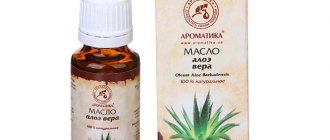Contractubex after cesarean section softens the postoperative scar and helps form a thin and invisible external suture. To get a good result, you need to start using the gel immediately after removing the suture material.
It is applied and rubbed in with a light massage 2-3 times a day for at least 3 months. For old scars, it takes at least six months. A good option is the Contractubex night patch; it is applied for 8-10 hours. Alternative products with a similar effect are Dermatix, Anti-scar, Mederma, Kelofibrase.
How Contractubex will help after caesarean section
Contractubex after cesarean section has a softening and anti-inflammatory effect on the skin scar. The drug also helps to form a thin and stretchable suture and prevents the formation of a dense and disfiguring keloid scar.
Under the influence of this external remedy, collagen fibers are located along the skin lines, there are no knotted structures or swirls. Regular use of the medication has the effect of lightening the skin, it acquires elasticity and normal moisture, and itching and tingling in the area of the postoperative suture stops.
We recommend reading the article about caring for sutures after a caesarean section. From it you will learn what a suture looks like after a cesarean section, the features of a cosmetic suture, how and how long it takes for a suture to heal, its treatment and care. And here is more information about the causes of abdominal numbness after cesarean section.
Composition and properties of Contractubex components
The drug contains allantoin, onion extract and heparin.
Onion extract
Onion extract stimulates wound healing and helps to form a thin and invisible seam. This is explained by its properties:
- relieves inflammation, prevents infection, disinfects;
- prevents the occurrence of an allergic reaction;
- stops excessive division of building cells (fibroblasts) and the formation of extracellular substance (matrix).
Heparin
Heparin has an anticoagulant effect and also:
- relieves swelling;
- suppresses the inflammatory response;
- inhibits the proliferation of rough connective tissue;
- increases hydration;
- softens the skin.
Allantoin
This component helps retain water in tissues, relieves inflammation, soothes and softens. Under its influence, wound healing accelerates and skin permeability to other components increases.
Contractubex: when to start using on a seam
After a caesarean section, Contractubex should be applied to the wound immediately after the stitches are removed. It is important that there is no open area. Most often this occurs 1 week after surgery, if there are no complications.
If the wound is weeping, then you must first treat it with an antiseptic solution (for example, Chlorhexidine or Furacilin) and lubricate it with wound-healing ointments (Spasatel, Levomekol).
Chlorhexidine solution Furacilin solution Levomekol Rescuer
As soon as the postoperative wound has healed completely, you should immediately begin applying the drug Contractubex in the form of a gel or night patch. It is very important that treatment is carried out as early as possible, since for a fresh scar only 3 months of use is enough, while old ones require at least 0.5-1 year and are difficult to treat.
26.11.2021
Suture after cesarean section: healing process, care and recovery features
In modern obstetrics, caesarean section is a frequently performed operation. To remove the child, a transverse incision 10-15 cm long is made directly above the pubis, after which a neat cosmetic suture is applied. However, such a seam also requires some care.
After the anesthesia wears off, the mother feels pain in the lower abdomen, which requires additional pain relief in the hospital. Painful sensations may persist during the first weeks after surgery; as a rule, they do not require additional analgesics. “Silent” nagging pain in the suture area can be felt for up to a year.
Features of suture healing after a CS, as after any operation, are: compaction of the suture and the area around it, the release of a small amount of ichor and clear liquid from the incision - all this is normal. This is a natural healing process. The seam becomes soft after a year. Reasons to consult a doctor may include: discharge of pus, blood clots from the incision, localized swelling in the scar area, its increase with increased pain. Immediately after a cesarean section, numbness occurs in the lower abdomen. This occurs due to the intersection of small nerve fibers during the cut; sensitivity will occur after a few months, when the nerve fibers are restored again. 2-3 weeks after surgery you may experience itching in the suture area. Tissue healing is always accompanied by such symptoms. The process is long - the seam can itch for up to a year.
The main fear among women in labor is the possibility of the seam coming apart. The latter is rare. This complication can be determined by the following symptoms: the incision is very painful and swollen, redness is observed in this area, pus with blood and an unpleasant odor is released from the wound, and a rise in temperature is noted. In such a situation, you must immediately consult a doctor!
Normal healing process
Thanks to modern materials and well-established techniques for performing a cesarean section, the healing of the suture occurs quickly. The mother is discharged already on the 6-8th day, as a rule, after the stitches are removed, and self-absorbing ones “disappear” on their own after 1-2 months. While the woman is in the maternity hospital, medical staff monitors the healing of the suture, sterile dressings are changed daily, and the scar is regularly treated with antiseptics. After discharge, the mother will have to treat the suture; the rules are the same as in the hospital - daily change of the bandage, regular treatment of the wound with an antiseptic. After discharge from the maternity hospital, doctors prescribe follow-up examinations at the antenatal consultation stage.
It is better to treat the seam after a shower. Water procedures (just not taking a bath!) are allowed on the 8-10th day after surgery, because wounds heal faster on clean skin. Worried mothers don’t shower for weeks; this does more harm than good—failure to maintain hygiene can trigger the development of inflammation. A postoperative wound, as a rule, is treated first with peroxide and then with brilliant green; the doctor may prescribe other means: antibacterial ointments and solutions, powders, chlorhexidine, etc. After 2-3 weeks, if wound healing proceeds normally, treatment can be stopped. But it is necessary to continue monitoring the condition of the skin in this area. The seam is completely healed after 1-2 months.
Lifestyle tips for a better healing process after CS:
- do not lift weights exceeding 3-4 kg for two months,
- do not take hot baths for the first 3-6 months,
- Avoid exposure to high and low temperatures on the skin: saunas, tanning, severe frost,
- enhanced fitness, stretching exercises,
- wear underwear made from natural fabric for six months, it is important that the edges of the panties do not touch the seam,
- It is not allowed to scratch the wound until it has completely healed,
Women are often concerned about the appearance of the skin in the area of the formed scar after cesarean section. It will not be possible to completely get rid of the scar, but proper care and treatment, as well as special cream-gels to improve the appearance of the scar, will help make it less noticeable. They can be used only after the wound has completely healed, and for at least 2 months. These products help to significantly improve the appearance of both fresh and old scars. Sometimes the suture can heal with the formation of coarse hypertrophied scar tissue; the cause of this complication is usually the individual peculiarity of wound healing. Plastic surgery can help remove this cosmetic defect; alternatives include deep peeling, laser resurfacing or microdermabrasion.
Scar correction using cosmetic methods.
It is important to know that a scar also remains on the uterus after a cesarean section. Ultrasound helps monitor the healing of the suture on the uterus. It is carried out when a woman is discharged from the maternity hospital, then after 2 months; the adequacy of suture healing can be finally judged only after 6 months by ultrasound.
A woman who has had a caesarean section is advised to plan her next pregnancy no sooner than 2 years later. This period is considered optimal for stabilizing the uterine scar.
Regular visits to an obstetrician-gynecologist will reduce the risks of complications during scar healing; following all the doctor’s recommendations will help you properly prepare for the next pregnancy, which will inevitably affect its favorable course!
Obstetrician-gynecologist at the antenatal clinic of the State Healthcare Institution “City Clinic No. 4 of Grodno” Skvortsova O. O.
How much can you apply and how long can you use Contractubex after cesarean section?
In order for Contractubex gel treatment of a scar after cesarean to be as effective as possible, you need to:
- Start to rub a very thin layer of it from the center of the scar to the edges in a circular motion, slightly stretching the skin;
- use the drug every day at least 2-3 times;
- It is best to apply the product after a warm shower.
It is very convenient to use the new dosage form - the night adhesive plaster. It is glued to the scar for 8-10 hours, optimally at night. In addition to the constant release of active substances, the patch helps to further soften the skin by creating a greenhouse effect and compressing surrounding tissues.
During the period of using the drug Contractubex, the seam should not be exposed to direct sunlight, strong massage and cold. Depending on the response to treatment, rubbing or gluing the patch lasts from 2 to 4 months.
Perineal incision – no need to be afraid!
why is this necessary
In obstetrics, the term “perineum” refers to the small distance between the vagina and the anus. This is exactly the place that obstetricians and gynecologists have in mind when they talk about a rupture or incision in the perineum. During labor, the baby's head moves through the birth canal and reaches the pelvic floor, stretching the muscles and skin of the perineum. The maximum load on the perineal tissue is experienced during the second stage of labor, when the baby's head emerges. It is at this point that the perineum may rupture. To prevent this from happening, an episiotomy is made - a surgical incision in the perineal area, between the vagina and anus.
. A surgical incision is always better than a spontaneous rupture, because it has smooth edges and will heal faster than a laceration. In addition, the doctor can control the length of the incision, and a spontaneous rupture risks stretching over a long distance and to great depth.
How does this happen
The perineum is dissected at the end of the second stage of labor if characteristic signs of an approaching rupture appear - protrusion of the perineum, cyanosis, swelling, pale skin. The length of the incision is about 2–3 cm, and blood loss is minimal. And most importantly, this manipulation is completely painless: at the height of the push, the perineal tissues are so overstretched that the blood flow in them stops, and therefore no pain is felt
. But they stitch the incision under local anesthesia, so that again the woman does not feel any severe pain; they do this after the baby and the placenta are born. While the mother is in the maternity hospital, the midwife of the postpartum ward cleans the stitches with antiseptics every day. Sometimes in the first three days, if there is swelling in the area of the sutures, ice is applied to them.
and then what?
Those women who had a perineal incision made during childbirth will need to follow some rules. If after a normal birth with an episiotomy you are allowed to walk almost immediately (by the end of the first day for sure), then sit after an episiotomy
You can’t do it for two whole weeks – and this is the main inconvenience after this manipulation.
You will need to feed the baby in a supine position, and you will have to eat yourself while standing or lying down. If you still need to sit down (for example, you are going to travel in a car), you can use a seat cushion
(sold in pharmacies) or a children's inflatable swimming ring. You will be able to sit down completely when the stitches have completely healed: most often this happens in the first two weeks after birth.
In the first few days after birth, you should not strain too hard during bowel movements; if necessary, you can use a laxative.
taking care of the seam
· At home, you need to continue to treat the incision site - while still in the maternity hospital, you should ask the doctor what kind of antiseptic you will need and how often the suture should be treated.
· In order for the incision to heal faster and better, it is necessary to change postpartum pads frequently - every 3-4 hours. You can also give yourself air baths once or twice a day.
· After each visit to the toilet, you should wash the external genitalia and gently pat the perineum dry. In addition to regular running water, you can use a solution of chamomile and calendula.
· If there is swelling in the area of the sutures, you can apply a cooled gel pack and ice to them for a short time.
please pay attention
For some time after the episiotomy, there may be some pain in the suture area, perhaps burning, discomfort, irritation and swelling of the skin - this is normal: after all, there was a surgical intervention and it takes time for the tissue to recover. In general, the perineal incision most often heals without complications.
– only a small skin scar remains, which becomes almost invisible over time.
But sometimes healing is delayed or complicated by some kind of inflammation, for example, this happens if a woman has colpitis - inflammation of the vagina. Then the pain, swelling either intensifies or simply does not go away for a long time; a feeling of pulsation, twitching, bursting appears in the area of the suture, and there may even be purulent discharge. Then you should immediately consult a doctor, he will examine the stitch and prescribe treatment.
how to avoid
Of course, episiotomy during childbirth is not performed on everyone, but only when indicated. But still, every woman wants to avoid it. To do this, you need to behave correctly during childbirth: the main thing is that you shouldn’t clamp down, you must, on the contrary, try to “open up” as much as possible in order to release the child. How to do this, as well as how to behave during contractions and between them, how to breathe, what positions to take, how to reduce labor pain, will be taught at school to future parents. Such preparation, as well as an optimistic attitude, will help you endure the birth and, possibly, avoid an incision.
And starting from 36 weeks of pregnancy, you can massage the perineum with oil
. And although there is no statistical evidence that such a massage reduces the likelihood of episiotomy, nevertheless, the perineal tissues will be slightly moistened, stretched, and the woman will feel her body better - all this is also a small prevention of surgical manipulation.
You should not think that episiotomy is done to everyone during childbirth “just in case,” as people far from medicine often write. No, the doctor and midwife also want to avoid this intervention as much as possible, so if you still had to do an episiotomy, treat it with understanding - after all, this incision helps keep the woman healthy.
Alternative means after surgery to smear the suture
The suture after a cesarean section can be lubricated with other ointments of a similar effect:
| Drug name | Short description | Photo |
| Kelofibrase | Contains urea, camphor and heparin. | |
| Dermatix | Silicone gel | |
| Anti-scar | Based on bischofite, onion extract | |
| Clearvin | Herbal remedy according to Ayurveda recipes | |
| Zeraderm ultra | Contains vitamins E and K, coenzyme Q10 | |
| Mederma | Active ingredients: onion extract and allantoin. |
Contractubex gel and medicinal patch are used after cesarean section to soften the scar. The sooner you start treatment, the faster the effect will be obtained.
Useful video
Watch the video about the use of Contractubex:
Similar articles
- A lump on the seam after a cesarean section: reasons for the compaction...
Why a lump appeared on the seam after a cesarean section. What are the symptoms of compaction under the seam? Why doesn't the swelling go down? What to do if a lump appears at the site of the suture after childbirth. Read more - Abdominal numbness after cesarean section: why does it go numb...
What are the causes of abdominal numbness after cesarean section? Why is the uterus and skin sore and numb? When the numbness goes away. What to do to quickly stabilize your condition after a caesarean section. Read more
- Suture after caesarean section: what happens, how to treat...
What are the sutures after a caesarean section - vertical, longitudinal transverse, their features, what they look like, which one is better. How long does it take for a suture to heal after a cesarean section, how to properly treat it and what to apply. Possible complications with the suture: inflamed, festered, itchy, hard, split. How long does it take for a seam to heal, how to remove it. Read more
- Scar on the uterus after cesarean section: what is it, classification...
How a scar is formed on the uterus after a cesarean section, what it is, what affects its consistency. Scar criteria for a second pregnancy, their classification. Is it possible to give birth if the scar is incompetent? How to conduct a second pregnancy, what tests and how many to take - ultrasound, MRI, hysteroscopy. Read more
- Endometriosis of postoperative scar after cesarean...
What provokes the appearance of endometriosis in a postoperative scar. What are the symptoms of a scar of the uterus, anterior abdominal cavity, wall. What treatment is possible, when is removal necessary? Is childbirth possible and how does it happen with endometriosis of the scar? Read more
What determines the process of recovery of the body after a caesarean section?
The recovery process after a natural birth and after a cesarean section depends on many factors: the characteristics of the course of pregnancy, the characteristics of the woman’s initial health state, the presence of chronic diseases, and the presence of complications during childbirth. It is also influenced by the characteristics of the operation: whether the woman had an emergency or planned cesarean section, what type of anesthesia was used, whether any complications occurred during the operation or during the extraction of the fetus, what type of incision was used, and so on. The adaptive capabilities of a woman’s body also play an equally important role.
Taking into account all these many factors, it is obvious that there are no two women whose postpartum period would be the same. Therefore, before being discharged from the maternity hospital, every woman needs to ask her doctor in great detail about what regime needs to be followed, what physical activity is acceptable in her condition, how often it is necessary to see a doctor on an outpatient basis, in what situations it is necessary to see a doctor immediately.
